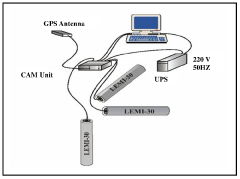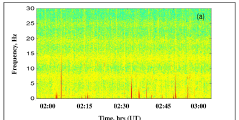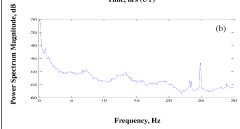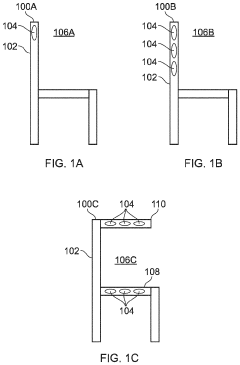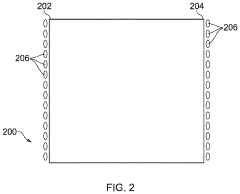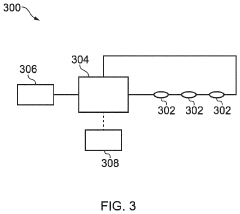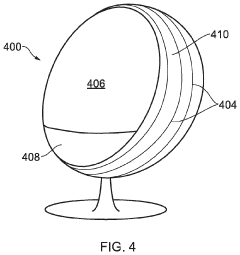Unraveling the Mysteries of Schumann Resonance Frequencies
JUN 24, 20259 MIN READ
Generate Your Research Report Instantly with AI Agent
Patsnap Eureka helps you evaluate technical feasibility & market potential.
Schumann Resonance Background and Objectives
The Schumann resonance, discovered by physicist Winfried Otto Schumann in 1952, is a set of spectrum peaks in the extremely low frequency (ELF) portion of the Earth's electromagnetic field spectrum. These resonances occur between the Earth's surface and the ionosphere, creating a global electromagnetic resonance phenomenon. The primary objective of studying Schumann resonances is to unravel their complex nature and understand their implications for various scientific disciplines.
The background of Schumann resonance research spans several decades, with initial theoretical predictions made in the early 20th century. However, it wasn't until Schumann's work that these resonances were formally described and measured. The fundamental frequency of Schumann resonances is approximately 7.83 Hz, with subsequent harmonics occurring at approximately 14.3, 20.8, 27.3, and 33.8 Hz.
These resonances are generated and maintained by lightning discharges in the cavity formed by the Earth's surface and the ionosphere. The global lightning activity, occurring at an average rate of about 50 flashes per second, acts as a natural excitation mechanism for these resonances. This constant electromagnetic activity creates a stable, albeit dynamic, resonance pattern that can be measured around the globe.
The study of Schumann resonances has evolved significantly since their discovery, driven by advancements in measurement techniques and a growing understanding of their potential applications. Initially, research focused on validating the theoretical predictions and establishing accurate measurement methodologies. As the field progressed, scientists began exploring the relationship between Schumann resonances and various geophysical and atmospheric phenomena.
One of the key objectives in Schumann resonance research is to leverage these frequencies as a tool for monitoring global lightning activity and studying the Earth's lower ionosphere. The resonances provide a unique, non-invasive method for probing the properties of the Earth-ionosphere cavity on a global scale. This has implications for understanding climate change, as variations in Schumann resonances may reflect changes in global temperature and thunderstorm activity.
Another significant goal is to investigate the potential biological effects of Schumann resonances. Some researchers hypothesize that these natural frequencies may influence biological rhythms and human health, although this remains a controversial area requiring further scientific scrutiny. The exploration of this potential connection aims to shed light on the intricate relationships between electromagnetic fields and living organisms.
The background of Schumann resonance research spans several decades, with initial theoretical predictions made in the early 20th century. However, it wasn't until Schumann's work that these resonances were formally described and measured. The fundamental frequency of Schumann resonances is approximately 7.83 Hz, with subsequent harmonics occurring at approximately 14.3, 20.8, 27.3, and 33.8 Hz.
These resonances are generated and maintained by lightning discharges in the cavity formed by the Earth's surface and the ionosphere. The global lightning activity, occurring at an average rate of about 50 flashes per second, acts as a natural excitation mechanism for these resonances. This constant electromagnetic activity creates a stable, albeit dynamic, resonance pattern that can be measured around the globe.
The study of Schumann resonances has evolved significantly since their discovery, driven by advancements in measurement techniques and a growing understanding of their potential applications. Initially, research focused on validating the theoretical predictions and establishing accurate measurement methodologies. As the field progressed, scientists began exploring the relationship between Schumann resonances and various geophysical and atmospheric phenomena.
One of the key objectives in Schumann resonance research is to leverage these frequencies as a tool for monitoring global lightning activity and studying the Earth's lower ionosphere. The resonances provide a unique, non-invasive method for probing the properties of the Earth-ionosphere cavity on a global scale. This has implications for understanding climate change, as variations in Schumann resonances may reflect changes in global temperature and thunderstorm activity.
Another significant goal is to investigate the potential biological effects of Schumann resonances. Some researchers hypothesize that these natural frequencies may influence biological rhythms and human health, although this remains a controversial area requiring further scientific scrutiny. The exploration of this potential connection aims to shed light on the intricate relationships between electromagnetic fields and living organisms.
Market Applications of Schumann Resonance
Schumann resonance frequencies have garnered significant attention in various market applications, spanning from health and wellness to environmental monitoring and technological advancements. In the health sector, these frequencies are being explored for their potential benefits in stress reduction and overall well-being. Companies are developing products such as resonance chambers and frequency generators that claim to replicate the natural Schumann resonance, aiming to improve sleep quality, reduce anxiety, and enhance cognitive function.
The environmental monitoring market has also found applications for Schumann resonance. Scientists and researchers utilize these frequencies as a tool for studying global climate patterns and electromagnetic phenomena. Specialized equipment designed to detect and analyze Schumann resonance signals is being developed and marketed to research institutions and environmental agencies. These tools contribute to our understanding of Earth's electromagnetic environment and its potential correlations with climate change and natural disasters.
In the realm of telecommunications, Schumann resonance has sparked interest in developing alternative communication systems. Some companies are exploring the possibility of using these low-frequency waves for long-distance communication, particularly in scenarios where traditional methods may be compromised or unavailable. This research could lead to innovative emergency communication systems or enhance existing global communication networks.
The aerospace industry has also recognized the potential of Schumann resonance. Space agencies and private companies are investigating how these frequencies might affect spacecraft and astronaut health during long-duration missions. This research could lead to the development of new shielding technologies or countermeasures to mitigate potential negative effects of space travel on human physiology.
In the realm of agriculture, some researchers are exploring the impact of Schumann resonance on plant growth and crop yields. Companies are developing experimental systems that expose plants to controlled Schumann resonance frequencies, aiming to enhance growth rates, improve crop resilience, and potentially increase agricultural productivity.
The emerging field of quantum computing has also shown interest in Schumann resonance. Researchers are investigating whether these natural frequencies could play a role in quantum information processing or serve as a stable reference for quantum systems. While still in its early stages, this research could potentially lead to novel quantum technologies and applications.
As the market applications of Schumann resonance continue to expand, it is crucial to approach these developments with scientific rigor and critical evaluation. While some applications show promise, others may require further research to validate their efficacy and safety. The growing interest in Schumann resonance across diverse industries underscores its potential significance in shaping future technologies and scientific understanding.
The environmental monitoring market has also found applications for Schumann resonance. Scientists and researchers utilize these frequencies as a tool for studying global climate patterns and electromagnetic phenomena. Specialized equipment designed to detect and analyze Schumann resonance signals is being developed and marketed to research institutions and environmental agencies. These tools contribute to our understanding of Earth's electromagnetic environment and its potential correlations with climate change and natural disasters.
In the realm of telecommunications, Schumann resonance has sparked interest in developing alternative communication systems. Some companies are exploring the possibility of using these low-frequency waves for long-distance communication, particularly in scenarios where traditional methods may be compromised or unavailable. This research could lead to innovative emergency communication systems or enhance existing global communication networks.
The aerospace industry has also recognized the potential of Schumann resonance. Space agencies and private companies are investigating how these frequencies might affect spacecraft and astronaut health during long-duration missions. This research could lead to the development of new shielding technologies or countermeasures to mitigate potential negative effects of space travel on human physiology.
In the realm of agriculture, some researchers are exploring the impact of Schumann resonance on plant growth and crop yields. Companies are developing experimental systems that expose plants to controlled Schumann resonance frequencies, aiming to enhance growth rates, improve crop resilience, and potentially increase agricultural productivity.
The emerging field of quantum computing has also shown interest in Schumann resonance. Researchers are investigating whether these natural frequencies could play a role in quantum information processing or serve as a stable reference for quantum systems. While still in its early stages, this research could potentially lead to novel quantum technologies and applications.
As the market applications of Schumann resonance continue to expand, it is crucial to approach these developments with scientific rigor and critical evaluation. While some applications show promise, others may require further research to validate their efficacy and safety. The growing interest in Schumann resonance across diverse industries underscores its potential significance in shaping future technologies and scientific understanding.
Current Challenges in Schumann Resonance Research
Despite significant advancements in Schumann resonance research, several challenges persist in fully understanding and utilizing these natural electromagnetic frequencies. One of the primary obstacles is the difficulty in accurately measuring and isolating Schumann resonances from other electromagnetic noise. The extremely low frequency (ELF) range of these resonances, typically between 7.83 Hz and 45 Hz, requires highly sensitive equipment and sophisticated signal processing techniques to detect and analyze.
Environmental factors pose another significant challenge. Solar activity, geomagnetic storms, and human-made electromagnetic interference can all affect the measurement and interpretation of Schumann resonances. Researchers must develop robust methods to differentiate between natural variations in the resonances and those caused by external influences, which is often a complex task.
The global nature of Schumann resonances presents logistical challenges for comprehensive study. To fully understand these phenomena, a network of monitoring stations distributed across the globe is necessary. However, establishing and maintaining such a network requires substantial resources and international cooperation, which can be difficult to achieve and sustain.
Another ongoing challenge is the limited understanding of the biological effects of Schumann resonances. While some studies suggest potential impacts on human health and circadian rhythms, the mechanisms behind these effects and their long-term implications remain largely unknown. Conducting rigorous, controlled studies on biological impacts is complicated by the ubiquitous nature of these resonances and the difficulty in isolating their effects from other environmental factors.
The interdisciplinary nature of Schumann resonance research also presents challenges. It requires expertise from various fields, including atmospheric physics, geophysics, electrical engineering, and biomedical sciences. Bridging these diverse disciplines and fostering effective collaboration is crucial for advancing our understanding but can be challenging in practice.
Lastly, there is a need for more advanced theoretical models that can accurately predict and explain the behavior of Schumann resonances under various conditions. Current models often struggle to account for all the complexities of the Earth-ionosphere cavity and its interactions with solar and geomagnetic phenomena. Developing more comprehensive models is essential for interpreting observational data and predicting future behavior, but it requires significant computational resources and innovative approaches in mathematical modeling.
Environmental factors pose another significant challenge. Solar activity, geomagnetic storms, and human-made electromagnetic interference can all affect the measurement and interpretation of Schumann resonances. Researchers must develop robust methods to differentiate between natural variations in the resonances and those caused by external influences, which is often a complex task.
The global nature of Schumann resonances presents logistical challenges for comprehensive study. To fully understand these phenomena, a network of monitoring stations distributed across the globe is necessary. However, establishing and maintaining such a network requires substantial resources and international cooperation, which can be difficult to achieve and sustain.
Another ongoing challenge is the limited understanding of the biological effects of Schumann resonances. While some studies suggest potential impacts on human health and circadian rhythms, the mechanisms behind these effects and their long-term implications remain largely unknown. Conducting rigorous, controlled studies on biological impacts is complicated by the ubiquitous nature of these resonances and the difficulty in isolating their effects from other environmental factors.
The interdisciplinary nature of Schumann resonance research also presents challenges. It requires expertise from various fields, including atmospheric physics, geophysics, electrical engineering, and biomedical sciences. Bridging these diverse disciplines and fostering effective collaboration is crucial for advancing our understanding but can be challenging in practice.
Lastly, there is a need for more advanced theoretical models that can accurately predict and explain the behavior of Schumann resonances under various conditions. Current models often struggle to account for all the complexities of the Earth-ionosphere cavity and its interactions with solar and geomagnetic phenomena. Developing more comprehensive models is essential for interpreting observational data and predicting future behavior, but it requires significant computational resources and innovative approaches in mathematical modeling.
Measurement Techniques and Instrumentation
01 Measurement and detection of Schumann resonance frequencies
Various devices and methods are used to measure and detect Schumann resonance frequencies. These include specialized sensors, antennas, and signal processing techniques to isolate and analyze the extremely low frequency (ELF) electromagnetic waves associated with Schumann resonances.- Measurement and detection of Schumann resonance frequencies: Various devices and methods are developed to measure and detect Schumann resonance frequencies. These systems often involve specialized sensors, antennas, and signal processing techniques to accurately capture and analyze the low-frequency electromagnetic waves associated with Schumann resonances.
- Applications in health and wellness: Schumann resonance frequencies are utilized in various health and wellness applications. Devices and methods are designed to generate or simulate these frequencies, which are believed to have potential benefits for human well-being, relaxation, and stress reduction.
- Communication and signal processing: Schumann resonance frequencies are explored for potential use in communication systems and signal processing applications. This includes techniques for enhancing signal transmission, reducing interference, and improving the efficiency of wireless communication systems operating at extremely low frequencies.
- Environmental monitoring and geophysical research: Schumann resonance frequencies are utilized in environmental monitoring and geophysical research. Systems and methods are developed to study global electromagnetic phenomena, atmospheric conditions, and potential correlations with seismic activities or other natural events.
- Energy harvesting and power generation: Research is conducted on harnessing Schumann resonance frequencies for energy harvesting and power generation purposes. This includes the development of specialized antennas and circuits designed to capture and convert these low-frequency electromagnetic waves into usable electrical energy.
02 Applications in wireless communication and energy harvesting
Schumann resonance frequencies are utilized in wireless communication systems and energy harvesting technologies. These applications leverage the natural electromagnetic waves to enhance signal transmission or convert ambient electromagnetic energy into usable power.Expand Specific Solutions03 Health and wellness applications
Schumann resonance frequencies are incorporated into various health and wellness devices and therapies. These applications aim to synchronize biological rhythms with Earth's natural frequencies, potentially offering benefits for relaxation, stress reduction, and overall well-being.Expand Specific Solutions04 Environmental monitoring and geophysical research
Schumann resonance frequencies are used in environmental monitoring and geophysical research. By analyzing variations in these frequencies, researchers can study global lightning activity, ionospheric conditions, and potential correlations with climate change or seismic events.Expand Specific Solutions05 Electromagnetic shielding and interference mitigation
Technologies have been developed to shield against or mitigate interference from Schumann resonance frequencies in sensitive electronic equipment. These solutions are particularly important for precision instruments and communication systems operating in the ELF range.Expand Specific Solutions
Key Research Institutions and Scientists
The exploration of Schumann Resonance Frequencies is in its early stages, with a growing market driven by applications in geophysics, environmental monitoring, and potential health effects. The technology's maturity is still developing, as evidenced by the diverse range of institutions involved. Academic institutions like the University of California, Technion Research & Development Foundation, and University of Bern are at the forefront of research. Industry players such as HP Development Co. LP and Koninklijke Philips NV are also showing interest, indicating potential commercial applications. The involvement of organizations like Naval Research Laboratory suggests strategic importance. As research progresses, we can expect increased collaboration between academia and industry to unlock the full potential of Schumann Resonance Frequencies.
Technion Research & Development Foundation Ltd.
Technical Solution: Technion Research & Development Foundation Ltd. has developed advanced sensors and signal processing techniques to detect and analyze Schumann resonance frequencies. Their approach involves using highly sensitive magnetometers coupled with sophisticated algorithms to filter out noise and isolate the specific frequencies associated with Schumann resonances. This technology enables real-time monitoring of global electromagnetic activity and potential correlations with various geophysical and atmospheric phenomena.
Strengths: Cutting-edge sensor technology and advanced signal processing. Weaknesses: Limited commercial applications and high equipment costs.
The Regents of the University of California
Technical Solution: The University of California has developed a network of ground-based ELF (Extremely Low Frequency) receivers to study Schumann resonances. Their system uses multiple stations across different geographical locations to triangulate and analyze the global electromagnetic resonances. The data collected is used to investigate the relationship between Schumann resonances and various atmospheric and ionospheric phenomena, as well as potential applications in earthquake prediction and space weather monitoring.
Strengths: Comprehensive global monitoring network and extensive data analysis capabilities. Weaknesses: High maintenance costs for multiple stations and complex data interpretation.
Breakthrough Discoveries in Schumann Resonance
Noval strategy of schumann resonance phenomena at a low latitude stationand their estabilishment thereof
PatentInactiveIN202011054143A
Innovation
- The use of three-component search coil magnetometers (LEMI-30) installed at low latitude stations to measure magnetic field variations, combined with GPS synchronization and data analysis using MATLAB, to record and analyze Schumann resonance phenomena, allowing for the isolation of Schumann signals and correlation with ground surface temperature for environmental monitoring.
A magnetic field exposure system and uses thereof
PatentPendingUS20230372726A1
Innovation
- A magnetic field exposure system generating an amplitude-modulated low frequency magnetic field with a carrier frequency of 360 to 450 Hz and a modulation frequency of 0.5 to 100 Hz, providing a field strength of 0.5 to 250 μT, specifically designed to enhance cell survival, proliferation, reduce stress, and promote tissue regeneration.
Environmental Factors Affecting Schumann Resonance
The Schumann resonance frequencies, a set of electromagnetic oscillations in Earth's atmosphere, are significantly influenced by various environmental factors. These factors play a crucial role in modulating the characteristics and behavior of Schumann resonances, affecting their intensity, frequency, and overall patterns.
One of the primary environmental factors impacting Schumann resonances is solar activity. The sun's electromagnetic emissions and solar wind interact with Earth's magnetosphere and ionosphere, altering the conductivity of the upper atmosphere. During periods of high solar activity, such as solar flares or coronal mass ejections, the ionosphere becomes more ionized, leading to changes in the propagation of electromagnetic waves and, consequently, affecting the Schumann resonance frequencies.
Seasonal variations also play a significant role in shaping Schumann resonances. The Earth's tilt and its orbit around the sun result in varying levels of solar radiation reaching different parts of the planet throughout the year. This seasonal fluctuation impacts the ionosphere's properties, leading to observable changes in Schumann resonance parameters. For instance, studies have shown that the fundamental Schumann resonance frequency tends to be slightly higher during local summer months compared to winter months.
Meteorological conditions, particularly global lightning activity, are another critical factor influencing Schumann resonances. Lightning strikes are the primary natural source of excitation for these resonances. The global distribution and intensity of thunderstorms, which vary with geographical location and season, directly affect the strength and characteristics of Schumann resonances. Regions with high thunderstorm activity, such as the tropics, contribute significantly to the overall Schumann resonance signal.
Human activities and technological advancements have also begun to impact Schumann resonances. The increasing use of wireless communication technologies and power distribution systems introduces artificial electromagnetic noise into the Earth-ionosphere cavity. This anthropogenic noise can potentially interfere with or modify the natural Schumann resonance signals, although the extent of this impact is still a subject of ongoing research.
Climate change and its associated effects on atmospheric composition and dynamics may also influence Schumann resonances in the long term. Changes in global temperature patterns, atmospheric moisture content, and the frequency and intensity of extreme weather events could alter the conditions necessary for the propagation of electromagnetic waves within the Earth-ionosphere waveguide.
Understanding these environmental factors and their complex interactions is crucial for accurately interpreting Schumann resonance data and utilizing it for various scientific and practical applications. Continued research in this area will provide valuable insights into the Earth's electromagnetic environment and its response to both natural and anthropogenic influences.
One of the primary environmental factors impacting Schumann resonances is solar activity. The sun's electromagnetic emissions and solar wind interact with Earth's magnetosphere and ionosphere, altering the conductivity of the upper atmosphere. During periods of high solar activity, such as solar flares or coronal mass ejections, the ionosphere becomes more ionized, leading to changes in the propagation of electromagnetic waves and, consequently, affecting the Schumann resonance frequencies.
Seasonal variations also play a significant role in shaping Schumann resonances. The Earth's tilt and its orbit around the sun result in varying levels of solar radiation reaching different parts of the planet throughout the year. This seasonal fluctuation impacts the ionosphere's properties, leading to observable changes in Schumann resonance parameters. For instance, studies have shown that the fundamental Schumann resonance frequency tends to be slightly higher during local summer months compared to winter months.
Meteorological conditions, particularly global lightning activity, are another critical factor influencing Schumann resonances. Lightning strikes are the primary natural source of excitation for these resonances. The global distribution and intensity of thunderstorms, which vary with geographical location and season, directly affect the strength and characteristics of Schumann resonances. Regions with high thunderstorm activity, such as the tropics, contribute significantly to the overall Schumann resonance signal.
Human activities and technological advancements have also begun to impact Schumann resonances. The increasing use of wireless communication technologies and power distribution systems introduces artificial electromagnetic noise into the Earth-ionosphere cavity. This anthropogenic noise can potentially interfere with or modify the natural Schumann resonance signals, although the extent of this impact is still a subject of ongoing research.
Climate change and its associated effects on atmospheric composition and dynamics may also influence Schumann resonances in the long term. Changes in global temperature patterns, atmospheric moisture content, and the frequency and intensity of extreme weather events could alter the conditions necessary for the propagation of electromagnetic waves within the Earth-ionosphere waveguide.
Understanding these environmental factors and their complex interactions is crucial for accurately interpreting Schumann resonance data and utilizing it for various scientific and practical applications. Continued research in this area will provide valuable insights into the Earth's electromagnetic environment and its response to both natural and anthropogenic influences.
Schumann Resonance in Space Exploration
The exploration of Schumann Resonance in space represents a fascinating frontier in our understanding of electromagnetic phenomena beyond Earth's atmosphere. These resonances, typically observed on Earth as electromagnetic waves trapped between the planet's surface and the ionosphere, have potential implications for space exploration and extraterrestrial habitation.
Recent studies have shown that Schumann Resonances can be detected in the atmospheres of other planets and moons within our solar system. This discovery opens up new possibilities for using these resonances as a tool in space exploration. For instance, the detection and analysis of Schumann Resonances could provide valuable information about the atmospheric composition and electrical properties of other celestial bodies, aiding in the search for potentially habitable environments.
In the context of space missions, understanding Schumann Resonances could be crucial for maintaining the health and well-being of astronauts during long-duration space flights. Earth's Schumann Resonances are thought to play a role in regulating human circadian rhythms and overall health. As such, researchers are exploring ways to artificially recreate these resonances in spacecraft to mitigate the potential negative effects of prolonged exposure to the space environment on human physiology.
Furthermore, the study of Schumann Resonances in space could lead to advancements in communication technologies for interplanetary missions. These natural electromagnetic waves could potentially be harnessed as a means of long-distance, low-power communication between spacecraft and planetary bases, offering an alternative to traditional radio communication methods.
The investigation of Schumann Resonances in space also contributes to our understanding of space weather phenomena. By studying how these resonances interact with solar wind and cosmic rays, scientists can gain insights into the complex electromagnetic environment of our solar system and its potential impact on space exploration activities.
As space agencies and private companies set their sights on establishing permanent bases on the Moon and Mars, the role of Schumann Resonances in these environments becomes increasingly relevant. Research is ongoing to determine how these resonances might be utilized or replicated to create more Earth-like conditions in extraterrestrial habitats, potentially easing the psychological and physiological challenges of long-term space colonization.
In conclusion, the study of Schumann Resonances in the context of space exploration represents a multifaceted and promising field of research. As we continue to unravel the mysteries of these electromagnetic phenomena beyond Earth, we may unlock new possibilities for space travel, communication, and habitation, bringing us closer to realizing our ambitions of becoming a truly spacefaring civilization.
Recent studies have shown that Schumann Resonances can be detected in the atmospheres of other planets and moons within our solar system. This discovery opens up new possibilities for using these resonances as a tool in space exploration. For instance, the detection and analysis of Schumann Resonances could provide valuable information about the atmospheric composition and electrical properties of other celestial bodies, aiding in the search for potentially habitable environments.
In the context of space missions, understanding Schumann Resonances could be crucial for maintaining the health and well-being of astronauts during long-duration space flights. Earth's Schumann Resonances are thought to play a role in regulating human circadian rhythms and overall health. As such, researchers are exploring ways to artificially recreate these resonances in spacecraft to mitigate the potential negative effects of prolonged exposure to the space environment on human physiology.
Furthermore, the study of Schumann Resonances in space could lead to advancements in communication technologies for interplanetary missions. These natural electromagnetic waves could potentially be harnessed as a means of long-distance, low-power communication between spacecraft and planetary bases, offering an alternative to traditional radio communication methods.
The investigation of Schumann Resonances in space also contributes to our understanding of space weather phenomena. By studying how these resonances interact with solar wind and cosmic rays, scientists can gain insights into the complex electromagnetic environment of our solar system and its potential impact on space exploration activities.
As space agencies and private companies set their sights on establishing permanent bases on the Moon and Mars, the role of Schumann Resonances in these environments becomes increasingly relevant. Research is ongoing to determine how these resonances might be utilized or replicated to create more Earth-like conditions in extraterrestrial habitats, potentially easing the psychological and physiological challenges of long-term space colonization.
In conclusion, the study of Schumann Resonances in the context of space exploration represents a multifaceted and promising field of research. As we continue to unravel the mysteries of these electromagnetic phenomena beyond Earth, we may unlock new possibilities for space travel, communication, and habitation, bringing us closer to realizing our ambitions of becoming a truly spacefaring civilization.
Unlock deeper insights with Patsnap Eureka Quick Research — get a full tech report to explore trends and direct your research. Try now!
Generate Your Research Report Instantly with AI Agent
Supercharge your innovation with Patsnap Eureka AI Agent Platform!
